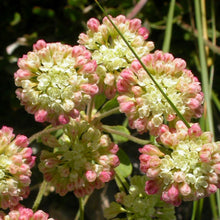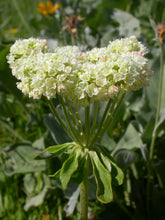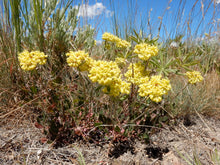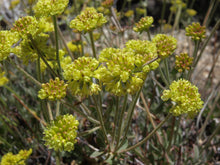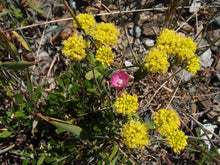
Eriogonum umbellatum
Sulphur-flower buckwheat is a fuss-free, low-growing evergreen that is perfect for areas that are exposed with dry, well-drained soil. This species has many varieties that intergrade, so characteristics like height and flower color can vary widely - embrace the unknown and enjoy the surprise! Generally, its arrowhead-shaped leaves are grayish-green with a wooly texture. They will stick around all year, but fresh new growth emerges with the onset of spring, followed by compact clusters of flowers in May that can range from creamy white, to bright yellow, or even shades of pink. Regardless of variety, the blooms attract and support pollinators, then fade into seed pods that are feasted on by backyard birds in the late season.
- Plant type/canopy layer: deciduous, perennial, herbaceous plant/prostrate shrub
- Size at maturity: usually up to 14” tall, 0-48” wide
- Light requirements: full sun
- Moisture requirements: dry soil, must be very well-drained
- Bloom time: May - September
- Growth rate/ease: moderate to slow growing, very easy to grow
- Wildlife support: flowers attract and provide nectar to adult butterflies, bees and other insect pollinators; overall plant is caterpillar host and larval food source for up to 50 species of native butterflies and bees including the Acmon Blue moth, the Dotted Blue moth, and the Sheridan's Hairstreak moth.
- Native habitat/range: relatively common growing in dry soils and open or rocky places, at low, mid or alpine elevations, with a wide distribution across much of western Canada and the United State - except in the exceptionally moist, coastal areas. Portland Plant List - no.
- Special features & uses: deer resistant; evergreen; groundcover; medicinal, particularly well-understood and used by indigenous peoples; landscape uses include ecoroofs, pollinator gardens and rock gardens
Gardening with Sulphur-flowered Buckwheat: This carefree species is difficult to find in retail nurseries and therefore uncommon in habitat gardens. What better reason to get a couple and try them in your sunny, pollinator-friendly garden! Be sure the soil is loose and gravelly or rocky, with fast drainage - perhaps interplanted between companion shrubs that thrive in similar conditions like species of Ceanothus or Manzanita.
Photo Credit 1 - 3: "Eriogonum umbellatum" by Matt Lavin is licensed under CC BY-SA 2.0.
Photo Credit 4: "Nevada sulphurflower, Eriogonum umbellatum var. nevadense" by Jim Morefield is licensed under CC BY-SA 2.0.
Photo Credit 5: Nikkie West, Sparrowhawk Native Plants





